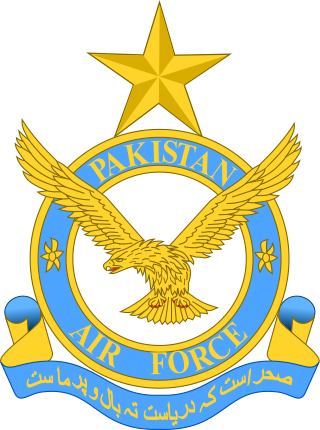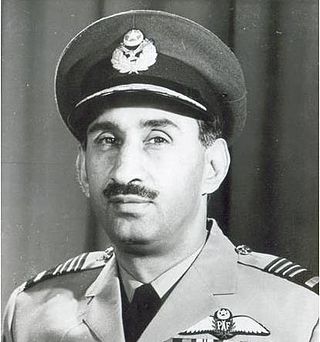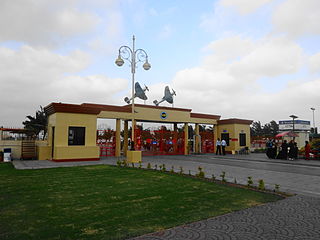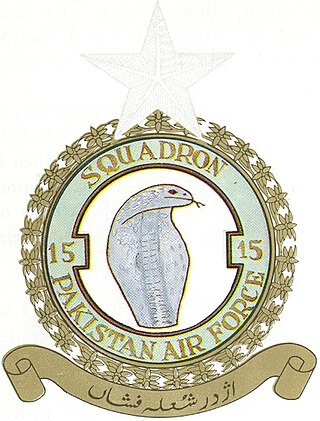
Since the Partition of British India in 1947 and subsequent creation of the dominions of India and Pakistan, the two countries have been involved in a number of wars, conflicts, and military standoffs. A long-running dispute over Kashmir and cross-border terrorism have been the predominant cause of conflict between the two states, with the exception of the Indo-Pakistani War of 1971, which occurred as a direct result of hostilities stemming from the Bangladesh Liberation War in erstwhile East Pakistan.

The English Electric Canberra is a British first-generation, jet-powered medium bomber. It was developed by English Electric during the mid- to late 1940s in response to a 1944 Air Ministry requirement for a successor to the wartime de Havilland Mosquito fast bomber. Among the performance requirements for the type was an outstanding high-altitude bombing capability and high speed. These were partly accomplished by making use of newly developed jet-propulsion technology. When the Canberra was introduced to service with the Royal Air Force (RAF), the type's first operator, in May 1951, it became the service's first jet-powered bomber.

The Hawker Hunter is a transonic British jet-powered fighter aircraft that was developed by Hawker Aircraft for the Royal Air Force (RAF) during the late 1940s and early 1950s. It was designed to take advantage of the newly developed Rolls-Royce Avon turbojet engine and the swept wing, and was the first jet-powered aircraft produced by Hawker to be procured by the RAF. On 7 September 1953, the modified first prototype broke the world air speed record for aircraft, achieving a speed of 727.63 mph.

The Pakistan Air Force (PAF) is the aerial warfare branch of the Pakistan Armed Forces, tasked primarily with the aerial defence of Pakistan, with a secondary role of providing air support to the Pakistan Army and Pakistan Navy when required, and a tertiary role of providing strategic airlift capability to Pakistan. As of 2024, as per the International Institute for Strategic Studies, the PAF has more than 70,000 active-duty personnel. PAF is the largest Air Force of the Muslim world in terms of aircraft fleet. Its primary mandate and mission is "to provide, in synergy with other inter-services, the most efficient, assured and cost effective aerial defence of Pakistan." Since its establishment in 1947, the PAF has been involved in various combat operations, providing aerial support to the operations and relief efforts of the Pakistani military. Under Article 243, the Constitution of Pakistan appoints the President of Pakistan as the civilian Commander-in-Chief of the Pakistan Armed Forces. The Chief of the Air Staff (CAS), by statute a four-star air officer, is appointed by the President with the consultation and confirmation needed from the Prime Minister of Pakistan.

The Indian Air Force (IAF) is the air arm of the Indian Armed Forces. Its primary mission is to secure Indian airspace and to conduct aerial warfare during armed conflicts. It was officially established on 8 October 1932 as an auxiliary air force of the British Empire which honoured India's aviation service during World War II with the prefix Royal. After India gained independence from United Kingdom in 1947, the name Royal Indian Air Force was kept and served in the name of the Dominion of India. With the transition to a republic in 1950, the prefix Royal was removed.
This is a list of aviation-related events from 1965.

The Indo-Pakistani war of 1965, also known as the second India–Pakistan war, was an armed conflict between Pakistan and India that took place from August 1965 to September 1965. The conflict began following Pakistan's unsuccessful Operation Gibraltar, which was designed to infiltrate forces into Jammu and Kashmir to precipitate an insurgency against Indian rule. The seventeen day war caused thousands of casualties on both sides and witnessed the largest engagement of armoured vehicles and the largest tank battle since World War II. Hostilities between the two countries ended after a ceasefire was declared through UNSC Resolution 211 following a diplomatic intervention by the Soviet Union and the United States, and the subsequent issuance of the Tashkent Declaration. Much of the war was fought by the countries' land forces in Kashmir and along the border between India and Pakistan. This war saw the largest amassing of troops in Kashmir since the Partition of India in 1947, a number that was overshadowed only during the 2001–2002 military standoff between India and Pakistan. Most of the battles were fought by opposing infantry and armoured units, with substantial backing from air forces, and naval operations.

Malik Nur Khan was a Pakistan Air Force officer, politician and statesman who served as sixth commander-in-chief of the Pakistan Air Force from 1965 to 1969. He later served as the sixth governor of West Pakistan from 1969 to 1970.

The Dassault MD.454 Mystère IV is a 1950s French fighter-bomber aircraft, the first transonic aircraft to enter service with the French Air Force. It was used in large-scale combat in the Israeli Air Force during the 1967 Six Day War.

Mushaf Ali MirNI(M), HI(M), SI(M), SBt was a Pakistani four-star air officer who served as the Chief of Air Staff of the Pakistan Air Force (PAF), appointed on 20 November 2000 until his accidental death in a plane crash on 20 February 2003.

Pakistan Air Force Museum Faisal is the official museum of the Pakistan Air Force located on the south-western edge of PAF Base Faisal near Karsaz Flyover on Shahrah-e-Faisal at Karachi. The museum is the only military aviation museum in Pakistan, with more than 50 aircraft, radars and missiles on display. The museum draws thousands of visitors each day making it one of the most frequently visited tourist attractions in Karachi.
Operation Chengiz Khan was the code name assigned to the preemptive strikes carried out by the Pakistani Air Force (PAF) on the forward airbases and radar installations of the Indian Air Force (IAF) on the evening of 3 December 1971, and marked the formal initiation of hostilities of the Indo-Pakistani War of 1971. The operation targeted 11 of India's airfields and also included artillery strikes on Indian positions in Kashmir. The targets were the Indian Airbases of Amritsar, Ambala, Agra, Awantipur, Bikaner, Halwara, Jodhpur, Jaisalmer, Pathankot, Bhuj, Srinagar and Uttarlai and air defence radars at Amritsar and Faridkot.
The Indian Air Force was established on 8 October 1932 independently of the army and navy and in a similar format to the British Royal Air Force. It had been a recommendation of the Skeen Committee, which had been tasked to look into demands for the Indianisation of the Indian army. Its first squadron was raised on 1 April 1933.

During the Indo-Pakistani war of 1965, the Indian and Pakistani Air Forces engaged in large-scale aerial combat for the first time. In the air war, which took place in September, both air forces conducted thousands of defensive and offensive sorties over Indian and Pakistani airspace. Both India and Pakistan claimed victory in the air war; Pakistan claimed to have destroyed 104 Indian aircraft and lost 19, and India claimed to have destroyed 73 Pakistani aircraft and lost 35 of its own. The air war ended in a stalemate.

The Central Air Command is one of the five operational commands of the Indian Air Force. It is currently headquartered in Prayagraj in Uttar Pradesh. It was formed on 19 March 1962, at Rani Kuthee, Calcutta.
Jamal Ahmad Khan AfridiNI(M) HI(M) SJ SI(M) SBt is a retired four-star air officer who served as the Chief of Air Staff of the Pakistan Air Force from 1985 until 1988. He also commanded the United Arab Emirates Air Force from 1977 until 1980.
Pushpindar Singh Chopra was an aviation journalist, historian, businessman and the author of several books, chiefly on military aviation history of India. His work and developments on Indian Aviation lead to the Fairchild-Dornier 288 production in India. He is known as the 'Chronicler of Aviation History' and 'Guru of Indian Aviation'.

The No. 15 Squadron, nicknamed Cobras, is a tactical attack squadron of the Pakistan Air Force (PAF). The Squadron is currently based at PAF Base Minhas in Kamra, Punjab, Pakistan and equipped with Chengdu J-10C multirole fighter jets. The Squadron also carries the honour of achieving the first kill for the PAF.

The No. 14 Squadron, nicknamed Tail Choppers, is an air superiority squadron of the Pakistan Air Force's Central Air Command. It is one of PAF's most decorated squadrons which earned its nickname after a daring strike mission on the Kalaikunda Air Force Station during the 1965 War. Currently, the Squadron is deployed at PAF Base Rafiqui and operates the PAC JF-17 Thunder multirole aircraft.














